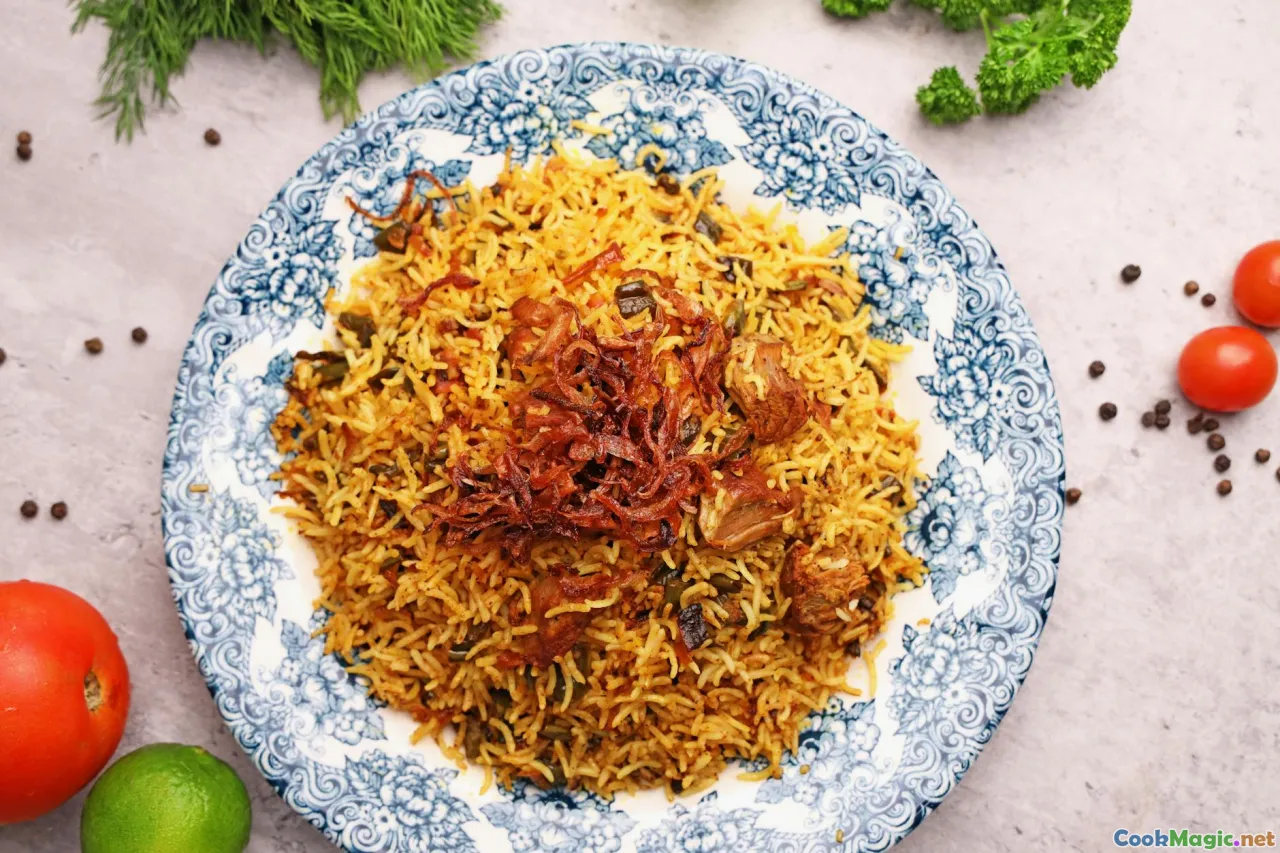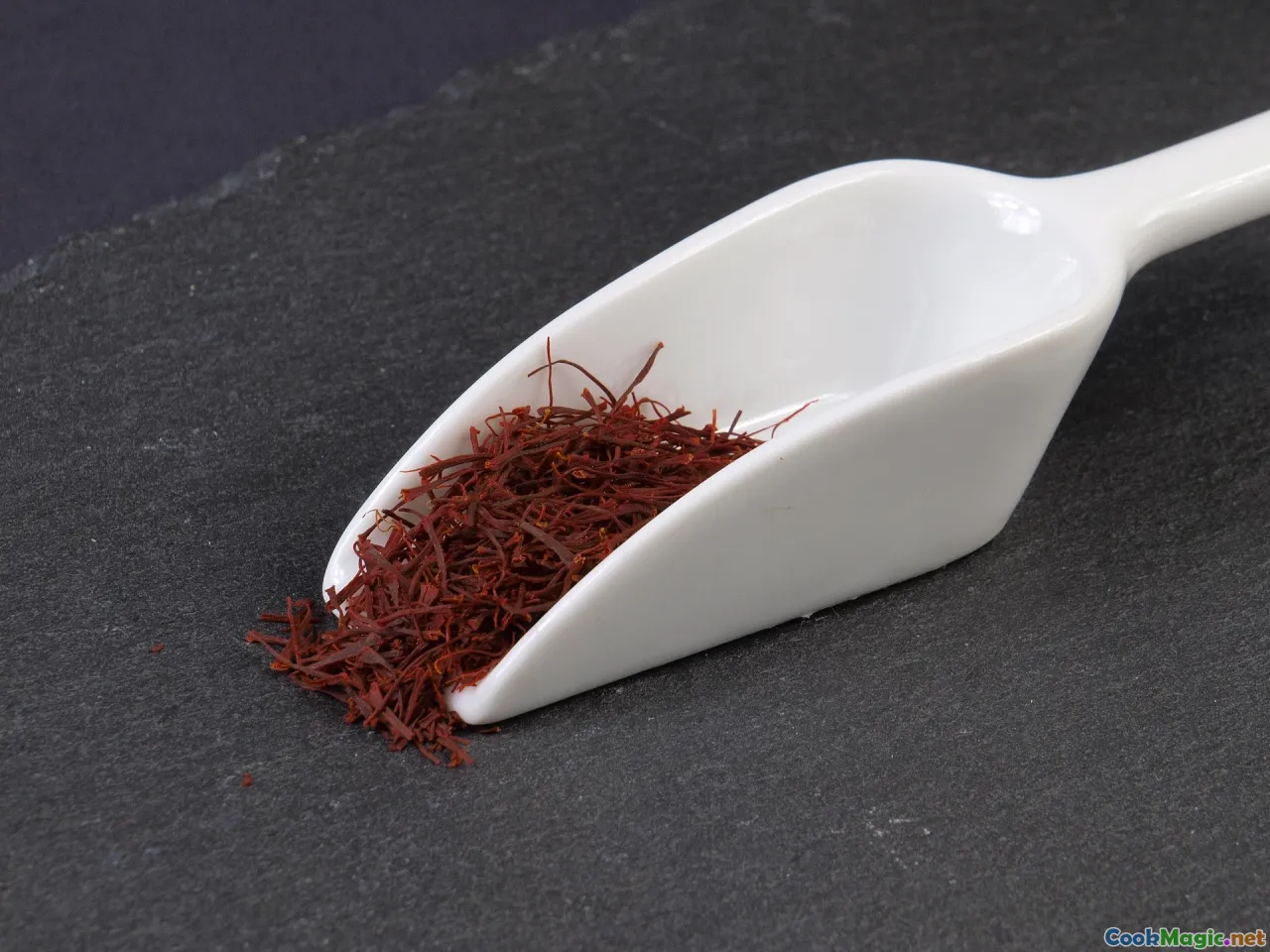
Cơm Sabzi Polo Ba Tư tẩm nghệ tây kèm Tahdig
(Saffron Persian Herb Polow with Tahdig)
(0 Đánh giá)0
367
tháng 10 28, 2025
Báo cáo sự cố
Nguyên liệu
-
400 grams Gạo Basmati (hạt dài)
(Rinse until water runs clear; soak 20 minutes)
-
1 cup Thì là tươi
(Băm nhỏ)
-
1 cup Ngò tây lá phẳng
(Băm nhỏ)
-
0.5 cup Ngò rí
(Băm nhỏ)
-
0.75 cup đọt hành
(Thinly sliced (or use chives))
-
1 tsp lá methi khô (shanbalileh)
(Potent—use sparingly or omit if unavailable)
-
3 cloves Tỏi
(Băm)
-
1 medium Khoai tây Russet
(Peeled, sliced 3 mm for tahdig)
-
0.5 tsp Saffron
(Bloom in 3 tbsp hot water)
-
3 tbsp Bơ không muối
(Melted; ghee also works)
-
3 tbsp Dầu trung tính
(For tahdig and pot)
-
2 tbsp Sữa chua không đường
(For extra-crisp tahdig paste)
-
2 tbsp Barberries (zereshk)
(Rinsed; for tart garnish)
-
1 tsp Vỏ chanh
(Finely grated; brightens herbs)
-
0.25 tsp Nghệ
(Colors and perfumes tahdig)
-
2 tbsp Muối kosher
(For boiling rice; plus 1 tsp for layering)
-
0.5 tsp Hạt tiêu đen
(Xay mới)
-
2 liters Nước
(For boiling rice)
-
3 tbsp Nước nóng
(To bloom saffron)
(Rinse until water runs clear; soak 20 minutes)
(Băm nhỏ)
(Băm nhỏ)
(Băm nhỏ)
(Thinly sliced (or use chives))
(Potent—use sparingly or omit if unavailable)
(Băm)
(Peeled, sliced 3 mm for tahdig)
(Bloom in 3 tbsp hot water)
(Melted; ghee also works)
(For tahdig and pot)
(For extra-crisp tahdig paste)
(Rinsed; for tart garnish)
(Finely grated; brightens herbs)
(Colors and perfumes tahdig)
(For boiling rice; plus 1 tsp for layering)
(Xay mới)
(For boiling rice)
(To bloom saffron)
Dinh dưỡng
- Khẩu phần: 4
- Kích thước khẩu phần: 1 đĩa (250g)
- Calories: 430 kcal
- Carbohydrates: 0 g
- Protein: 8 g
- Fat: 13 g
- Fiber: 4 g
- Sugar: 2 g
- Sodium: 580 mg
- Cholesterol: 15 mg
- Calcium: 90 mg
- Iron: 3.2 mg
Hướng dẫn
-
1 - Rinse and soak rice:
Place rice in a bowl and rinse several times until water runs nearly clear. Cover with fresh water and soak for 20 minutes to elongate the grains.
-
2 - Bloom the Saffron:
Lightly crush saffron threads with a pinch of sugar using a mortar and pestle. Pour 3 tbsp hot water over and let it bloom to release color and aroma.
-
3 - Chop the Herbs:
Finely chop dill, parsley, cilantro, and scallion greens. If using garlic and lemon zest, prepare them now. Keep herbs fluffy—not wet—so they steam well.
-
4 - Parboil the Rice:
Bring 2 liters of water to a boil with 2 tbsp kosher salt. Drain soaked rice and add to the pot. Boil 6–7 minutes until grains are soft at the edges yet firm inside.
-
5 - Drain and Season:
Drain rice in a colander. Toss gently with black pepper and about 1 tsp salt. Melt butter; reserve 1 tbsp for finishing. Mix a few spoonfuls of rice with yogurt if using.
-
6 - Prepare Tahdig Base:
Heat a heavy pot over medium. Add 2 tbsp oil, 1 tbsp butter, and turmeric (if using). Arrange potato slices in a shingle layer. Spread the yogurt-rice paste over potatoes.
-
7 - Layer Rice and Herbs:
Add a third of rice, scatter a third of herbs and garlic. Repeat layers, ending with rice. Drizzle half the bloomed saffron and 1 tbsp oil over the top. Poke 5 steam vents.
-
8 - Steam to Fluffy Perfection:
Cover pot with a towel-wrapped lid. Steam on low for 25–30 minutes until rice is tender, separate, and tahdig is crisp. Avoid lifting the lid early.
-
9 - Finish and Garnish:
Warm remaining saffron with a splash of butter. If using barberries, briefly sauté in 1 tsp oil until glossy. Fluff rice and fold in remaining herbs and lemon zest.
-
10 - Serve with Tahdig:
Invert the pot to release potato tahdig or loosen with a spatula. Serve rice mounded, drizzled with saffron butter, and crown with shards of golden tahdig and barberries.
Place rice in a bowl and rinse several times until water runs nearly clear. Cover with fresh water and soak for 20 minutes to elongate the grains.
Lightly crush saffron threads with a pinch of sugar using a mortar and pestle. Pour 3 tbsp hot water over and let it bloom to release color and aroma.
Finely chop dill, parsley, cilantro, and scallion greens. If using garlic and lemon zest, prepare them now. Keep herbs fluffy—not wet—so they steam well.
Bring 2 liters of water to a boil with 2 tbsp kosher salt. Drain soaked rice and add to the pot. Boil 6–7 minutes until grains are soft at the edges yet firm inside.
Drain rice in a colander. Toss gently with black pepper and about 1 tsp salt. Melt butter; reserve 1 tbsp for finishing. Mix a few spoonfuls of rice with yogurt if using.
Heat a heavy pot over medium. Add 2 tbsp oil, 1 tbsp butter, and turmeric (if using). Arrange potato slices in a shingle layer. Spread the yogurt-rice paste over potatoes.
Add a third of rice, scatter a third of herbs and garlic. Repeat layers, ending with rice. Drizzle half the bloomed saffron and 1 tbsp oil over the top. Poke 5 steam vents.
Cover pot with a towel-wrapped lid. Steam on low for 25–30 minutes until rice is tender, separate, and tahdig is crisp. Avoid lifting the lid early.
Warm remaining saffron with a splash of butter. If using barberries, briefly sauté in 1 tsp oil until glossy. Fluff rice and fold in remaining herbs and lemon zest.
Invert the pot to release potato tahdig or loosen with a spatula. Serve rice mounded, drizzled with saffron butter, and crown with shards of golden tahdig and barberries.
Thông tin thêm về: Cơm Sabzi Polo Ba Tư tẩm nghệ tây kèm Tahdig
Why this dish shines
Saffron Infused Persian Herb Polow (Sabzi Polo) is a celebration of freshness and fragrance. Imagine long-grain basmati that steams up fluffy and separate, each kernel perfumed with saffron and greened with a confetti of dill, parsley, cilantro, and scallion. Then there’s tahdig—the golden, crisp bottom crust that diners jockey for at the table. In this version, thin coins of potato create a shatteringly crisp base that contrasts beautifully with the tender rice above.
Key techniques for success
- Rinse and soak: Persian-style polow depends on elongated, separate grains. Rinsing washes off surface starch; soaking hydrates the core so the parboil cooks the exterior just enough.
- Parboil, don’t fully cook: Boiling the rice until the edges are soft but the center remains al dente is essential. The final steam finishes the center without turning the grains sticky.
- Bloom saffron properly: A few threads go a long way. Lightly crush and bloom in hot water to unlock color and aroma, then drizzle over the rice before steaming and again at the finish.
- Create a reliable tahdig: Potatoes are beginner-friendly—they act like edible insurance. A yogurt-rice paste helps “glue” the layer and encourages browning. Keep the heat medium-low during steaming; tahdig forms best with patient heat.
- Steam with a towel-wrapped lid: Trapping steam while preventing condensation from dripping back is the secret to fluffy rice. The towel absorbs excess moisture for feathery results.
Flavor notes and variations
- Classic herb profile: Dill leads with its anisey freshness, balanced by parsley’s herbaceous backbone and cilantro’s citrusy pop. Scallion greens lend gentle allium sweetness. A pinch of dried fenugreek adds haunting, springlike notes.
- Citrus lift: A whisper of lemon zest brightens the herbs without overshadowing saffron.
- Tart jewels: Barberries (zereshk) deliver pops of sour-sweet that contrast the buttery rice. If you can’t source them, chopped dried cranberries soaked and quickly sautéed make a reasonable stand-in.
- Tahdig alternatives: Instead of potato, try lavash bread or a pure rice tahdig (no potato) for a lighter crunch. For a deeper golden hue, add a pinch of turmeric to the fat.
- Protein pairings: Traditionally served at Nowruz with fried fish. It also pairs beautifully with grilled salmon, saffron chicken skewers, or pan-seared tofu for a vegetarian plate.
Tips and troubleshooting
- Rice too sticky? Rinsing was insufficient or you overcooked in the parboil stage. Aim for firm centers when draining.
- Pale tahdig? Increase the initial fat slightly and extend steam time a few minutes. Ensure even contact of potatoes with the pot surface.
- Burnt base? Heat was too high. After the first 5 minutes to set the crust, maintain low, steady heat for gentle steaming.
- Salt balance: Persian rice is seasoned in the boiling water. Don’t fear the 2 tablespoons—it largely drains away, leaving just the right baseline seasoning.
- Make-ahead: Parboil, drain, and cool rice up to 2 hours ahead. Steam just before serving. Leftovers reheat well in a covered skillet with a few drops of water.
Cultural context and significance
Sabzi Polo is inseparable from Nowruz, the Persian New Year, which celebrates renewal and spring. The green herbs symbolize rebirth and the fresh start a new season brings. Saffron—precious and warmly aromatic—signals festivity. At family tables, the first sound you’ll often hear is the collective sigh when the pot is inverted and the tahdig releases intact, a small triumph welcomed with applause. It’s a dish that invites participation: one person fluffs the rice, another crumbles tahdig, and a third drizzles the saffron butter like liquid gold.
Ingredient insights
- Rice: Aged basmati is ideal because it cooks up long and separate. If using a different long-grain variety, reduce soak time and watch the parboil closely.
- Herbs: Freshness matters. Dry the herbs well after washing; excess moisture can turn the rice damp. You can pulse herbs in short bursts in a food processor, but avoid a paste.
- Saffron: Buy threads, not powder, and look for deep red stigmas. A tiny pinch infuses the whole pot with color and aroma; too much can taste medicinal.
Unique aspects of this version
This recipe layers saffron twice—once before steaming and once as a finishing drizzle—building complexity without overpowering the herbs. The potato tahdig provides a dramatic, photogenic crust, while the optional yogurt paste offers added insurance for crunch. The seasoning stays restrained so the fresh greens and saffron shimmer.
Serving suggestions
- Add wedges of lemon or a bowl of mast-o-khiar (yogurt-cucumber) for cool contrast.
- Pair with simply salted, pan-fried white fish or roasted vegetables. A crisp salad of cucumbers and herbs complements the rice’s fragrance.
Final thoughts
Saffron Infused Persian Herb Polow is a masterclass in gentle technique—each step simple on its own, yet together delivering a dish of elegance and texture. With a little patience, you’ll achieve airy grains, vibrant greens, and the all-important golden tahdig that makes every bite a celebration.





















